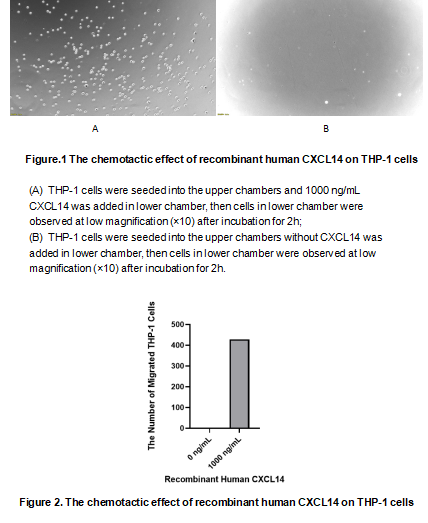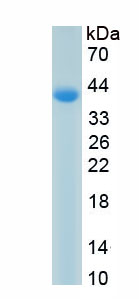Active Chemokine (C-X-C Motif) Ligand 14 (CXCL14) 

BRAK; SCYB14; BRAK; NJAC; Bolekine; Kec; MIP2-G; MIP2g; BMAC; KS1; Breast And Kidney Expressed Chemokine; Small Inducible Cytokine Subfamily B(Cys-X-Cys)Member 14
- UOM
- FOB US$ 211.00 US$ 528.00 US$ 1,056.00 US$ 3,168.00 US$ 7,920.00
- Quantity
Overview
Properties
- Product No.APB607Hu01
- Organism SpeciesHomo sapiens (Human) Same name, Different species.
- ApplicationsCell culture; Activity Assays.
Research use only - DownloadInstruction Manual
- CategoryCytokineInfection immunity
- Buffer FormulationPBS, pH7.4, containing 0.01% SKL, 5% Trehalose.
- Traits Freeze-dried powder, Purity > 90%
- Isoelectric Point8.9
Sign into your account
Share a new citation as an author
Upload your experimental result
Review

Contact us
Please fill in the blank.
Activity test

Active Chemokine (C-X-C Motif) Ligand 14 (meiceguo ) is a member of the CXC chemokine superfamily (1-5). CXCL14 is expressed by a variety of immune and non-immune cells,such as monocytes and B cells stimulated by LPS. It has been demonstrated that CXCL14 is a highly selective chemoattractant for monocytes that have been treated with prostaglandin E2 or forskolin, agents that activate adenylate cyclase.
It also attracts certain cells of the immune system, including dendritic cells and antigen-engaged B cells, CCR7 central-memory T-Cells. Thus, chemotaxis assay used 24-well microchemotaxis system was undertaken to detect the chemotactic effect of recombinant human CXCL14 on the THP-1 cell line. Briefly, THP-1 cells were seeded into the upper chambers (200μL cell suspension,106 cells/mL in RPMI 1640 with FBS free) and CXCL14 (0.01ng/mL, 0.1ng/mL, 1ng/mL, 10ng/mL,100ng/mL and 1000 ng/mL diluted separately in serum free RPMI 1640 ) was added in lower chamber with a polycarbonate filter (8 μm pore size) used to separate the two compartments. After incubation at 37℃ with 5% CO2 for 2h, the filter was removed, then cells in low chamber were observed by inverted microscope at low magnification (×10) and the number of migrated cells were counted randomly (five fields for each filter). Result shows MIP-3α is able to induce migration of THP-1 cells. The migrated THP-1 cells in low chamber at low magnification (×10) were shown in Figure 1. Five fields of each chamber were randomly chosen, and the migrated cells were counted at magnification (×10). Statistical results were shown in Figure 2. The optimum chemotaxis of recombinant human CXCL14 occurs at 1-1000 ng/mL.
Usage
Reconstitute in 10mM PBS (pH7.4) to a concentration of 0.1-1.0 mg/mL. Do not vortex.
Storage
Avoid repeated freeze/thaw cycles. Store at 2-8°C for one month. Aliquot and store at -80°C for 12 months.
Stability
The thermal stability is described by the loss rate. The loss rate was determined by accelerated thermal degradation test, that is, incubate the protein at 37°C for 48h, and no obvious degradation and precipitation were observed. The loss rate is less than 5% within the expiration date under appropriate storage condition.
Increment services
-
 BCA Protein Quantification Kit
BCA Protein Quantification Kit
-
 Molecular Mass Marker for Protein
Molecular Mass Marker for Protein
-
 Monoclonal Antibody Customized Service
Monoclonal Antibody Customized Service
-
 Polyclonal Antibody Customized Service
Polyclonal Antibody Customized Service
-
 Protein Activity Test Experiment Service
Protein Activity Test Experiment Service
-
 Electrophoretic Mobility Shift Assay (EMSA) Experiment Service
Electrophoretic Mobility Shift Assay (EMSA) Experiment Service
-
 Buffer
Buffer
-
 Lentivirus Packaging Experiment Service
Lentivirus Packaging Experiment Service
-
 Adenovirus Packaging Experiment Service
Adenovirus Packaging Experiment Service
-
 Real Time PCR Experimental Service
Real Time PCR Experimental Service
-
 Spike RBD Protein (S-RBD)
Spike RBD Protein (S-RBD)
-
 Protein G
Protein G
-
 Protein A
Protein A







